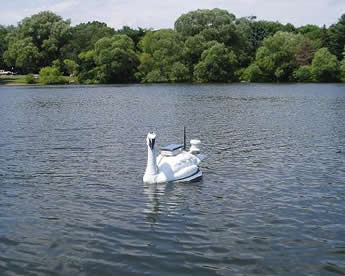Innovative Use of Real-Time Data and Sensor Networks in the Classroom: Fall 2007
On Saturday December 8 2007, teachers and science coordinators from the Milton and Boston Public School districts and ocean science researchers met at UMass Boston to give updates on their joint OSEI work, focusing on infusing real time data from ocean sensor networks into existing middle- and elementary-school curricula. Following on work conducted during the summer, each team gave a 30-minute presentation, including the development of their action plan, completed activities using real time data, classroom implementation, and dissemination plans. Each team provided a PowerPoint presentation and/or slide show to accompany their talk. All materials are available on the OSEI Google Group page.
Teams were encouraged to think about where and how to disseminate their work – conferences to present at, how to get published. Many teachers agreed that now that they know how great it is to have a scientist in the classroom, they will continue to do so.
Team Reports
Dr. Julie Ellis, seabird ecologist, worked with students in the Marine Biota Team to develop a curriculum based on Common Eider biology and conservation as part of her research on Eider die-offs. She made classroom visits in October to TechBoston Academy in Dorchester and Central Middle School in Quincy. At each school, she introduced the SEANET program and presented some findings from the ongoing SEANET research project on Common Eider mass mortality events at Cape Cod. Students at both schools are helping monitor beaches for dead or dying Eiders on Nantucket Island via a remotely-controlled video camera, set up by COSEE collaborator Mike Pollard from UMass Boston. In addition, Dr. Ellis presented curriculum based on Eider feeding habits and mortality. Eiders usually eat mussels, but due to mussel die-off they are now eating crabs. One hypothesis is that Eiders are ingesting a parasite from the crabs, causing the Eider die-off. Two Tufts veterinary students, Emily Christiansen and Nadia Stegeman, helped design a “crab dissection guide” for use in the classrooms. Dr Ellis provided crabs for the students so that they could conduct crab dissections and to help quantify the prevalence of acanthocephalan parasites in crabs.
In March, this lesson plan will be presented at the National Science Teachers Association Conference in Boston, where more teachers will be recruited to help develop new lesson plans related to SEANET research.
The participating teachers reported that their students (described as ‘highly motivated’) prepared by reading articles in the local paper about the die-offs, and made a trip to the beach, where they discussed the challenges of life there. The teachers described the crab dissection as being an excellent exercise that students enjoyed. On their own, students from the Central Middle School in Quincy MA made a 5-minute YouTube presentation on Asian crab dissection!
In response to recent beach closures due to high bacteria counts, researchers are working on ways to measure water quality. Teachers on the Water Quality Team introduced concepts such as:
- How do we know if a watershed is polluted?
- What are water quality measurements?
- Mapping your watershed with Google Earth
- The water cycle in the environment
- Real time data helping monitor the health of a body of water
- The use of real time water quality data in the classroom
The two schools involved in this project chose nearby ponds as sites for their research. Researchers made classroom visits and discussed the engineering design cycle involved in developing a remote sensor, as well as introducing the field of microbial ecology and its connection to water quality and bathing beach standards. One group launched the ‘swan’ data logger in their pond, which is now up and running and sending data to the classrooms.

Real time temperature, dissolved oxygen and turbidity are measured. The students will use local flow and climate data to evaluate how outflow from the pond changes and how it relates to the amount of e.coli bacteria. The other group will have the ‘swan’ installed in the spring. Teachers described the project as being a great culminating piece for science curriculum, being able to tie in with beach closures and whether the pond is an indicator of sustainable practices.
The Weather/Climate Team reports that scientists from Blue Hill Observatory in Milton MA worked with 8th grade earth science students using real time temperature data. The lesson plan included an introduction to concepts about temperature, including:
- Thermometer history
- Temperature scales
- Microclimates
- Heat transfer
- Perceived vs actual temperature
- How temperature is affected by color
The students were given HOBO dataloggers (manufactured by Onset Computer of Pocasset, MA; photo below) to use in the classroom, gathering and monitoring indoor temperature data.
The teachers plan on developing indoor and outdoor profiles with the HOBOs, and to correlate with a weather unit in the spring, including a field trip to Blue Hill Observatory.
At the Boston Public School's Harbor School, 6th grade students worked with weather tracking data, utilizing outdoor learning lesson plans. They took their HOBOs out to Spectacle Island in Boston Harbor, and safely secured the data loggers on two locations. Two days later they returned and retrieved the data. Other teachers discussed being able to access the same data, perhaps by plugging it into Google Earth – a real collaborative use! Teachers reported that the lesson plan (and trip to Spectacle Island!) has become an incentive for students.
Teachers at Concord Academy also developed curriculum using temperature sensors,
LCD thermometers, thermal infrared sensors and HOBO dataloggers. (Visit the OSEI Google Group page to view the PowerPoint for this curriculum.)